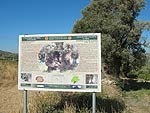| The
village of Anisaraki is situated a little northeast of Kandanos. In the
area two trees are registered:
|
| The olive
of Agios Georgios (N 35o 20.128', EO 23o 45.408'),
3.000 years old, is named after the nearby chuch. It belonged to the
so-called 'dekaochtoures' (trees that produce 18 mistata oil a year. 1
mistato is equivalent to 12 kg.) Now in its high age the tree produces
"only" 80-100 kg. Unfortunately the signs to the tree are
deficient.
|
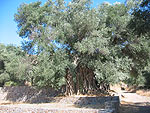 |
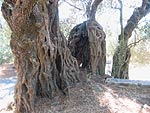 |
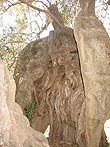
|
|
|
|
|
|
| In
the immediate vicinity
you find a crowd of other old
and
intereting trees, which are
called the "Femal Dancers" (Horéftries).
|
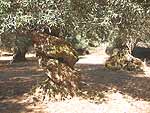 |
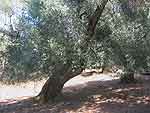 |

|
|
|
|
|
|
| Grambela
(N 35o 19.058', EO 23o 45.368'), 2.200 years old.
The large hollow (koufala) in the tree's trunk was in the past a
hidding-place for hunted Cretans. The tree is not signposted. |
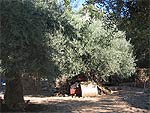
|
|
|
|
|
|
|
*****
|
|
| Vouves and
Ano Vouves are situated about 5 kilometres south of Kolymbari:
|
| Ano
Vouves (N 35o 29.212', EO 23o 47.217'), 2.500
years old. This tree is the first one to be registered in 2002, when it
was reserved.
|
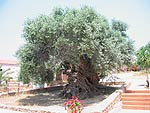 |
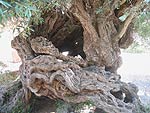 |
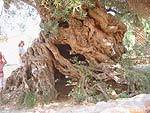
|
|
|
|
|
|
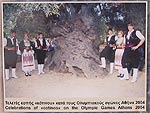 |
The
tree
delivered the branches for the
victory crown (cotinos) for
the winner of the Marathon
at the Olympic Games in Athens
2004. After the cut the
branches were sailed to Athens in a
copy of a Minoan ship. |
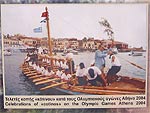
|
|
|
|
|
|
|
*****
|
|
| Palia
Roumata is situated approx. 6 kilometres south of Voukolies:
|
| Palia
Roumata (N 35o 24.110', EO 23o 46.740'), 2.400 years old.
Both during the Turkish period and the German occupation in World War 2
resistance fighters hid their weapons in the hollow tree.
|
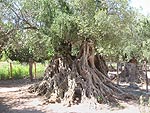 |
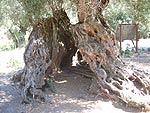 |
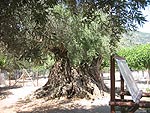
|
|
|
|
|
|
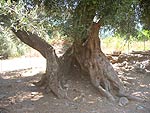 |
Next to
the tree there are several other ancient olive trees. |
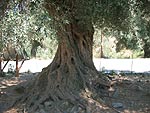
|
|
|
|
|
|
|
*****
|
|
| Samonas is
situated on the western slopes of the Apokoronas peninsula, southwest of
Stylos. The tree is placed in the southern outskirts of the village in an
area called Lakkos:
|
| Samonas
(N 35o 25.565', EO 24o 06.274'), 3.000 years old.
|
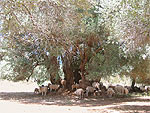 |
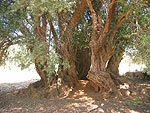 |
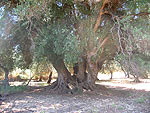
|
|
|
|
|
|
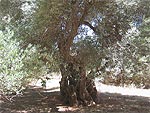 |
In the
area there are several very old trees. |
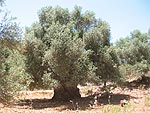
|
|
|
|
|
|
|
*****
|
|
| Kato
Tripodo is
situated southwest of Perama:
|
| Gre
Ele (N 35o 20.118', EO 24o 40.118'), 2.300 years old.
The name Gre Ele is Cretan dialect for gria elia (= old olive tree).
|
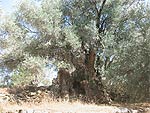 |
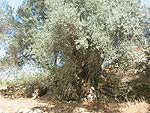 |
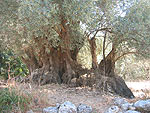
|
|
|
|
|
|
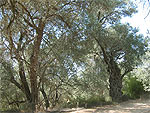 |
Behind
the tree is a grove
with several quite
old trees, where it
is nice to take
a nap
in the shade for an hour or two. |
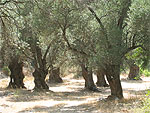
|
|
|
|
|
|
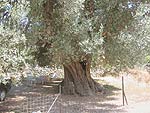 |
North of
the Gre Ele-tree at the settlement of Vergiana grow some other impressive
trees on both side of the road. |
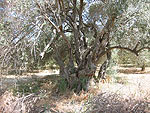
|
|
|
|
|
|
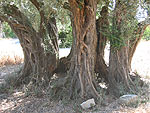 |
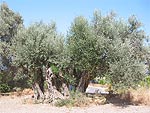 |

|
|
|
|
|
|
|
*****
|
|
| Genna
is
situated south of Agia Fotini in the nothern part of the Amari valley:
|
| Genna
(N 35o 15.139', EO 24o 38.607'), 2.300 years old.
Although the tree today appears as four trees close to one another, it is
in fact one tree with four main branches (there are traces of two more).
|
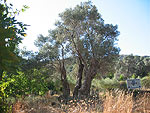 |
 |
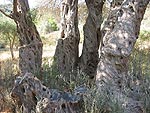
|
|
|
|
|
|
|
*****
|
|
| The now
abandoned village of Paliama is located south of Zaros:
|
| Paliama
(N 35o 06.377', EO 24o 55.277'), 3.000 years old.
|
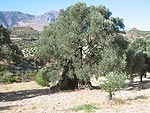 |
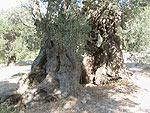 |
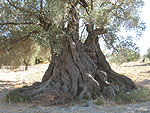
|
|
|
|
|
|
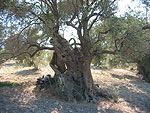 |
There are
also a couple of other old trees close to the Paliama-tree. |
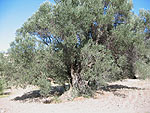
|
|
|
|
|
|
|
*****
|
|
| Gortyna is
situated on the plain of Messara, and directly across from the
archaelogical site you find this tree:
|
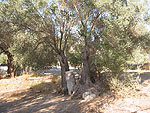 |
Gortyna
(N 35o 03.36.18', EO 24o 56.05'), 1.600 years
old. The
interesting thing about this tree is perhaps not so much its age, as the
fact that the tree has grown around a Roman pillar remnant,
which may have fallen from a building under the very violent earthquake
that hit Crete in 365. |
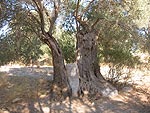
|
|
|
|
|
|
|
*****
|
|
| Panasos is
situated between Gergeri and Agia Varvara:
|
| Panasos
(N 35o 07.668', EO 24o 59.174'), 3.000 years old.
|
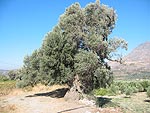 |
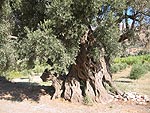 |
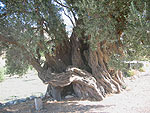
|
|
|
|
|
|
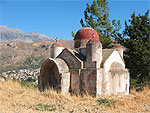 |
In
addition to the
tree, it is also worth visiting the
nearby, small church of Agia
Paraskevi, from where there is an excellent view
to the tree. |
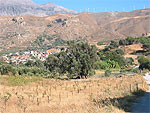
|
|
|
|
|
|
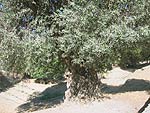 |
Next to
the small road leading to the tree you also find a few other old trees. |
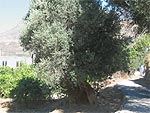
|
|
|
|
|
|
|
*****
|
|
| Kavousi is
situated a few kilometres east of Crete's narrowest point, north of
Ierapetra. The tree is situated southeast of the village:
|
| Kavousi
(N 35o 06.915', EO 25o 51.643'), 3.250 years old.
Probably this tree is the oldest in Crete. In 2004 the City Council of
Ierapetra decided that the female winner of the Maraton at the Olympic
Games should be crowned with a "cotinos" made of branches from
the tree. In short distance from the tree are located the Late Minoan
cities of Vronda, Azoria and Kastro, so it might be people from these
cities, who planted the tree in ancient time.år gammelt.
|
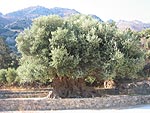 |
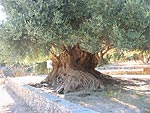 |
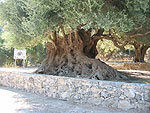
|
|
|
|
|
|
|
*****
|
|
| Lastros is
situated approximately 8 kilometres east of Kavousi. The tree is not
signmarked and it is a little difficult to find. But with help from the
locals, you will be able to find it.
|
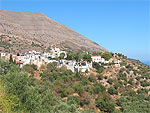 |
Mathaina's
olive, as the tree is called, grows next to a wall in the outskirts of the
village. |
|
|
|
|
|
| The
tree is
perhaps not the most impressive
in terms of size, but the hollow
is large and can easily
contain several people. The
village's inhabitants believe
that persons who have not
sinned, are
able to
see saints in
the foliage, and previously they used
to cut
branches of the tree for Palm
Sunday.
|
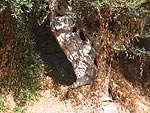 |
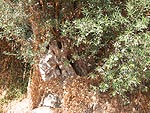 |
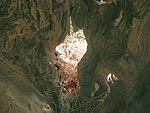
|
|
|
|
|
|
| The
village's
children are quite indifferent
about the tree's religious
significance, but love to play
hide and seek inside its
trunk. So did Michalis as a
child. He had the
kindness to take me
to the tree. Here
he is seen with
the café owner's mother.
|
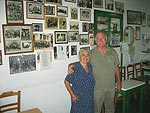
|
| I
can
recommend to park the car
in the square at the entrance
to the village and walk through
the picturesque narrows streets
and visit the
small café, whose walls
are adorned with old
photographies. |
|
|
|
|
|
|
*****
|
|
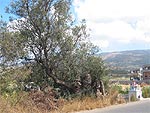 |
South
of
Sitia is a
tree that goes by the name Fourkolia,
next to the road a few
kilometers north of Piskokefalo.
The tree was a
few years ago badly damaged by
a car crash, however the
driver had a worse end, because he lost his life in the
collision. |
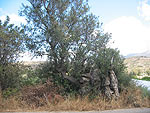
|
|
|
|
|
|
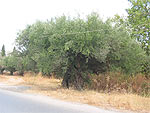 |
Some
hundred metres further on are two trees that are also worth looking at. |

|
|
|
|
|
|
|
|
|
|
|
|
|
|
|
|
|
|
|
|
|
|
